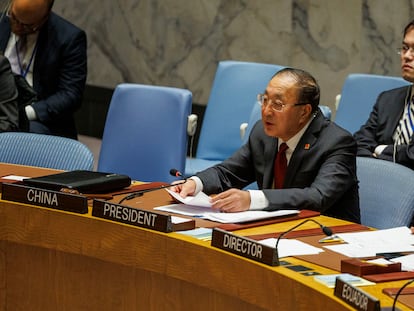Israel prolongs occupation of Gaza’s Al Shifa hospital in search of evidence of Hamas underground command center
The director of the largest medical center in the Palestinian enclave accuses the Israeli military of taking corpses and performing military operations in the emergency, radiology, neonatal and burns areas of the complex

Al Shifa hospital, the largest in Gaza, is still under Israeli army control and cannot be evacuated, despite still housing thousands of refugees and patients, according to health authorities in the Strip. A day and a half after its occupation, the military searched the facilities Thursday for evidence that the medical center houses a Hamas operations command in underground tunnels, as Israeli authorities have been insisting for weeks. So far, they have shown only a handful of weapons allegedly found during the search of the complex.
In addition, the Israeli army on Thursday found the body of Judith Weiss, a hostage held by Hamas. The Israeli Defense Forces (IDF) reported that her body was found in a structure adjacent to Al Shifa hospital. The body has already been transferred to Israeli territory. In a statement posted on its Telegram channel, the army stated that military equipment, including Kalashnikovs and rocket launchers, were also found in the structure where the body was located. Meanwhile, in the West Bank, an attack claimed by Hamas’ armed wing killed one Israeli soldier and wounded five on the outskirts of Jerusalem.
The director of Al Shifa, Mohammad Abu Salmiya, claims that the Israeli military has removed bodies and is digging trenches to surround the medical facility, according to statements made to Al Jazeera. The soldiers’ military operations within the hospital are focused on the radiology, neonatal, and burns units, in addition to the emergency room, he added. Salmiya estimates that in addition to some 5,000 refugees, there are still 500 medical staff and some 650 patients, including 36 premature babies, inside the hospital. More than 11,400 people have already been killed in the Israeli military operation in Gaza — according to the Hamas-controlled Ministry of Health in the enclave — in response to the October 7 Hamas attack, which left some 1,200 people dead and during which the Islamist militia took 240 hostages.
Israeli tanks attacked the Al Ahli hospital on Thursday, but its medical staff cannot move to treat the wounded, the Palestinian Red Crescent denounced through the social network X (formerly Twitter). The Al Ahli parking lot was already the scene of an explosion that killed between 100 and 300 people on October 17 following the impact of a projectile that, according to the Israeli government, was launched from inside Gaza itself.
U.N. High Commissioner for Human Rights Volker Türk on Thursday called on the parties to “immediately” accept the humanitarian pauses approved by the Security Council and demanded an international investigation. “Extremely serious allegations of multiple and profound breaches of international humanitarian law, whoever commits them, demand rigorous investigation and full accountability,” Türk told reporters in Geneva, as reported by Agence France Presse.
Türk took stock of his recent trip to the region, which took him, among other places, to the Rafah crossing on the Egyptian side of the border with Gaza. The U.N. official was, however, unable to visit either Israel or occupied Palestine due to the lack of permission from the Israeli authorities. Beyond the Strip, the High Commissioner expressed his concern “about the intensification of violence and severe discrimination against Palestinians in the occupied West Bank, including East Jerusalem.”
On the other hand, the heads of several U.N. agencies and international humanitarian organizations, including Türk himself, announced in a joint statement that they will not support the declaration of any “safe zone” that is not agreed upon by all parties in the conflict. They are thus staying out of unilateral decision-making. “We will not participate in the establishment of any ‘safe zone’ in Gaza that is set up without the agreement of all the parties, and unless fundamental conditions are in place to ensure safety and other essential needs are met and a mechanism is in place to supervise its implementation,” the heads of some twenty U.N. agencies and international NGOs — including UNICEF, the World Health Organization, the World Food Program and Save the Children — state in the text.
On October 18, after forcing more than one million inhabitants of northern Gaza to move south, the Israeli army directed the population towards Al Mawasi, a coastal area west of Khan Younis, which it called a “humanitarian zone,” where the distribution of aid would be organized. A large part of the displaced people fleeing the bombardments took refuge in both Khan Younis and Rafah, cities which, however, are also under Israeli attack.
The wind is increasingly blowing against Israeli Prime Minister Benjamin Netanyahu. His political survival is more and more in question after Israel — a country obessed with security — failed to prevent and immediately respond to the October 7 Hamas attack. On the one hand, hundreds of relatives of the Israeli hostages held in Gaza are currently undertaking a five-day protest march on foot from Tel Aviv to Jerusalem, which will take them to Netanyahu’s residence on Saturday. On the other, centrist Yair Lapid, short-lived prime minister last year, believes it is time to remove Netanyahu from office. He claimed on X (formerly Twitter) that a majority in Parliament would back a new coalition government led by Netanyahu’s own right-wing Likud party.
IDF presses into Gaza City
Meanwhile, IDF troops advance on Gaza City, considered the stronghold of Hamas. The army continues to disseminate footage of its self-perceived achievements, including blowing up the Hamas parliament building shortly after Israeli soldiers overtook it and took pictures of themselves — holding the Israeli flag — inside it. Also on Tuesday, the northern Gaza Strip residence of the head of Hamas’s political apparatus, Ismail Haniya, who resides abroad, came under aerial attack. Israel claims that the house was part of the “terrorist” infrastructure from which attacks against its territory were organized, despite the fact that Hamas’s armed wing has previously stated that the October 7 offensive was kept secret from the group’s political wing.
After several days of siege, Israeli troops stormed Al Shifa hospital in the early hours of Wednesday morning. Since then, the facility — without electricity, water, or food — has remained at the center of the war. Israel has insisted for weeks that Al Shifa houses Hamas’ central command in Gaza, a claim the militia denies. Videos released by the Israeli military in recent hours from inside the hospital show some weapons, bulletproof vests, documents, computers and CDs, which, they claim, prove that the health center was being used as a terrorist base. There is a “well-hidden terrorist infrastructure” inside the hospital, a military official told Reuters. IDF continues to search the facility for evidence to corroborate their claims.
A BBC team was granted permission to accompany Israeli soldiers inside Al Shifa, but the coverage did not confirm whether or not there is a Hamas command center underneath the medical complex. Military sources assured BBC reporters that computers found inside the hospital contained images of some of the hostages captured in the October 7 attack, but the British public television points out that its journalists were not authorized to see the contents of the computers.
Violence continues to spill to the West Bank
In parallel to the war in Gaza, tension is mounting in the occupied West Bank. The outskirts of Jerusalem were on Thursday morning the scene of a shooting incident in which one soldier was killed and five other people wounded. The three attackers were shot dead by Israeli security forces, according to police sources quoted by the Israeli press.
The incident took place on the road leading from Jerusalem to the south through the West Bank. The scene, a construction site, is adjacent to the West Bank city of Bethlehem. It’s a road heavily used by settlers from the numerous settlements in the area and by Palestinians moving towards the Hebron area or to other West Bank towns through the only military checkpoint that Israel is currently keeping open.
Since the outbreak of the conflict between Hamas and Israel on October 7, the number of roads cut off by Israeli security forces has multiplied in the West Bank. One of them is the one leading from Jerusalem to Bethlehem, barely a dozen kilometers, which means that the journey must be made along the road on which the attack took place, taking a detour of more than twice as many kilometers.
Sign up for our weekly newsletter to get more English-language news coverage from EL PAÍS USA Edition
Tu suscripción se está usando en otro dispositivo
¿Quieres añadir otro usuario a tu suscripción?
Si continúas leyendo en este dispositivo, no se podrá leer en el otro.
FlechaTu suscripción se está usando en otro dispositivo y solo puedes acceder a EL PAÍS desde un dispositivo a la vez.
Si quieres compartir tu cuenta, cambia tu suscripción a la modalidad Premium, así podrás añadir otro usuario. Cada uno accederá con su propia cuenta de email, lo que os permitirá personalizar vuestra experiencia en EL PAÍS.
¿Tienes una suscripción de empresa? Accede aquí para contratar más cuentas.
En el caso de no saber quién está usando tu cuenta, te recomendamos cambiar tu contraseña aquí.
Si decides continuar compartiendo tu cuenta, este mensaje se mostrará en tu dispositivo y en el de la otra persona que está usando tu cuenta de forma indefinida, afectando a tu experiencia de lectura. Puedes consultar aquí los términos y condiciones de la suscripción digital.
More information
Archived In
Últimas noticias
Welcome to the post-religion era: The idea of Christianity as the absolute truth has become obsolete
‘I thought you would like it’: The risky sexual practice popularized by TV shows and TikTok
The digitalization of tourism: ‘They promise experiences and gave us the worst possible one’
Mexican peso defies uncertainty with forecasts of a new period of stability in 2026
Most viewed
- Sinaloa Cartel war is taking its toll on Los Chapitos
- Oona Chaplin: ‘I told James Cameron that I was living in a treehouse and starting a permaculture project with a friend’
- Reinhard Genzel, Nobel laureate in physics: ‘One-minute videos will never give you the truth’
- Why the price of coffee has skyrocketed: from Brazilian plantations to specialty coffee houses
- Silver prices are going crazy: This is what’s fueling the rally










































